I had long dreamt of exploring New Caledonia. These days it seems less appealing. Perhaps it was the wrong place to visit 5 days after a 5-month long sojourn in New Zealand? Was that the reason? A transiting sailor's view will always be subjective however, and no one is obliged to agree with me. Yet the following is our account of our time there on board our catamaran.
Life in Noumea implies that one should head for the water at the weekend. And the huge New Caledonian lagoon is certainly not short of attractions. Skimming across the translucent waters and admiring the coral formations on board a habitable trimaran is an absolute must. The area around Nouméa is full of great places to head for at the end of the week. Sainte Marie, Canard, Maître, Signal, Larégnère, Pandanus and many more. Most of these coral islands are protected, and have just enough infrastructure to be able to welcome weekend sailors. Twice, we were part of a small, fun convoy of boats which headed out to Larégnère and then Pandanus, before enjoying a barbecue on the beach and water sports.
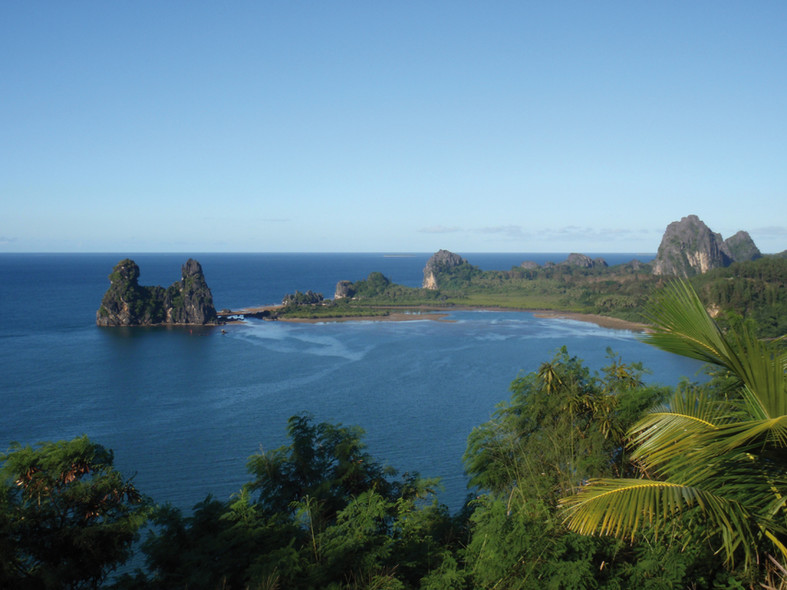
East coast landscapes in Hienghène, the heart of Kanak country…Jangada had arrived in New Caledonia!
Of course we visited the famous Jean-Marie Tjibaou Cultural centre in Tina, a few kilometers east of Nouméa. This was perhaps the first time that we were disappointed during our trip… This is a place which sets itself up as a symbol of reconciliation between the Melanesian and western worlds. However, it didn't really convince me, despite the external architecture being truly original. Its creation certainly helped to calm the emotions after the confrontations in the 1980s between the "Kanaks" and the "Caldoches". However, to be honest, having just spent five months in the land of the Long White Cloud, (where in general the Maori culture has been integrated fairly successfully by the western culture), arriving in New Caledonia with our eyes wide open, it was clear that there was still discord between the two communities. Some independence movements are still making extreme demands despite the almost shocking amount of metropolitan money that has been spent on this small territory since the beginning of the 1990s (certainly when compared to the standard of living in other parts of the region. Vanuatu for example). However, these demands do seem to be looking more and more archaic as the social and cultural mores move forward. This was a very disappointing assessment from our time in New Caledonia: as though there was a conversation between two groups, neither of which was listening, and where everyone seems to have forgotten that they are all immigrants on this rock. It seemed to us that those ageing historical figures who are still around should be encouraging the locals to be thinking about their common destiny. They cannot count on nickel any more, and the island's economic future is far from clear. France specializes in slowing things down, even on the other side of the world...
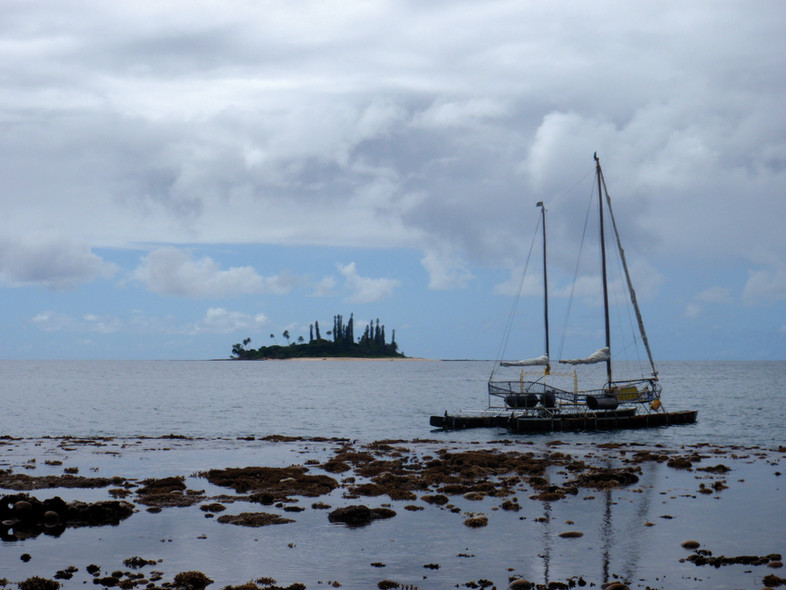
An unusual local multihull. This magazine's head tester Philippe Echelle probably knows all about it!
A Trip Around "Le Caillou…"
We sailed around New Caledonia for a few days, from north to south and east to west, so as to have a better feel for the interior of the island. We took a minimum amount of barbecuing and picnicking equipment, and every evening set up camp. New Caledonia is cigar-shaped: 400km long and only 50km wide. The two highest points are a little over 1600m. The east coast which is mainly populated by Kanaks, is caressed by the Trade Winds and receives plenty of rain. The coastline plunges into the sea and is covered in luxuriant vegetation. The west coast, which is mainly Caldoche is very sunny and the land slopes gently down towards the lagoon. The hills and mountains are rich in iron, but especially in nickel. New Caledonia has 25% of the world's nickel reserves. There are open cast mines which are a serious blight on the landscape.
We spotted some Cloven-Feathered Doves and the rarer Kagu, which do not fly, and some hummingbirds. The plentiful Rusa deer live in the bush in the interior. At the most northerly part of the country, the Great Northern Lagoon is home to the Belep Islands, and further on from them are the D’Entrecasteaux Reefs. A natural wonder, the New Caledonian lagoon, which lies opposite Australia's Great Barrier Reef, is home to a multitude of marine species, from humpback whales to dugongs, sharks to turtles, and from dolphins to the famous amphibious sea snakes with their yellow and blue colorings (one of around 15 different species of sea snakes in the lagoon!). That's without taking into account the plethora of birds (terns, noddys, petrels…) and over 4000 types of crustaceans, 2000 species of mollusk and other fish as well as 300 species of coral… what incredible biodiversity!
Our route saw us leaving the north of Nouméa, before passing by Dumbéa, Païta, La
Tontouta, Bouloupari, La Foa, Sarraméa, Farino, Moindou and Bourail. We arrived back on the east coast via the Houailou "crossing", before heading past Ponérihouen, Poindimié, Touho, Hienghène, (the heart of Kanak country), Pouébo, Ouégoa and Poum and Poingam in the extreme north (where Marin got a nasty sting from a ray on Nennon beach…) Koumac, Kaala-Gomen, Voh, Koné, Poimbout, Poya, and then Bourail, which meant we were heading south again back to Nouméa. We set out with a friend in his Ford Ranger 4x4 to spend two days in the south of the island. Mont-Dore, the lakes, Yaté, a crossing to the little island of Nuu in a dugout canoe, Goro Bay and then the torturous road to Prony where, at the top of a hillside we came face to face with the enormous Goro Nickel mining complex. This is a new factory, built by Vale, the Brazilian mining giant. All this had given us a good idea of what "Le Caillou" was all about, and it was now time to head out via the Havannah Canal on our way to the Loyalty Islands…
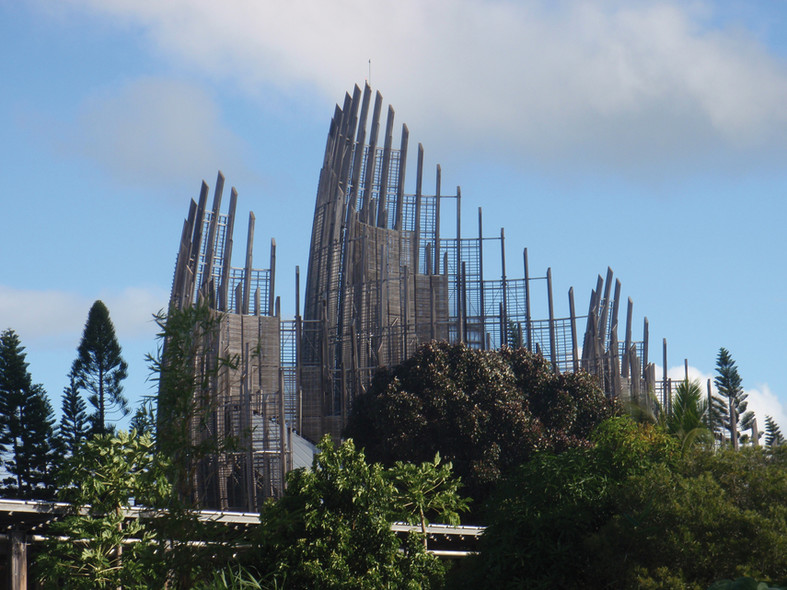
The Jean Marie Tjibaou cultural center. A fine building…
Stopovers in the Loyalty Islands…
In the afternoon of the 2nd May, we left Orphelinat Bay and the Petite Rade. There was no wind so we chugged along under motor over the calm waters of the lagoon. We dropped anchor in a creek along the Woodin Channel where we spent a quiet night. At daybreak, we set off again and left the lagoon by the Havannah. A light south south west wind meant that we could make progress towards the island of Maré, the most southerly and most visited of the Loyalty Islands. It's also the one which has stayed the most authentic. It was night time when we arrived in front of the small Tadine Bay where the local port is situated. It's just a basic jetty, a few dozen meters long, where there is a small quayside. There are just a few street lights to indicate the route along the coast. We approached slowly. Our electronic chart seemed slightly out of sync, and it was essential to use a hand-held lamp. We dropped anchor at the opening of the little port. There was a light swell and the sound of the waves breaking on the dead coral of the coastline was our night time mood music. There was a lovely beach at Wabao in the south, the remote hamlets of Medu and Eni, the little town of La Roche and the Yeiwene Yeiwene cultural center where a small local festival was taking place. Here I'll just go off message again… After the traditional speech given by the head of La Roche village, we had to listen to half an hour's rambling from a local dignitary, which sounded as though it was straight out of another era. An era where the "colonial power" was blamed for everything, while the Kanak culture was held up as exemplary. By all means celebrate Kanak culture, but let's not forget that the colonial power in question invests a lot of money in the Loyalty Islands, and the locals don't look particularly overworked. Throughout this journey, it amused me to consider the differences between how the French and British managed the "end of empire". The British were more pragmatic, money-conscious and concerned with keeping the public finances under control, while the French were rather over-generous handing out the taxpayers' cash. End of "off message"!
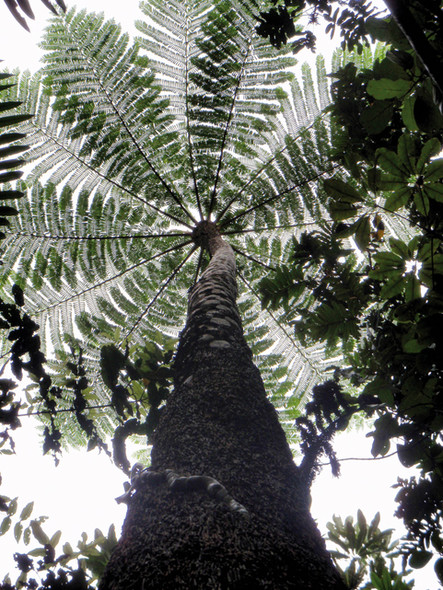
A lovely visit on land for our little crew, in the Grand Fougères provincial park.
The island of Maré reminded me of the island of Niue. Similar geographical layout, a coral island, and a similar, dense but not necessarily luxuriant vegetation. Life seems to pass by quite peacefully. However, our second night in our anchorage reserved a nasty surprise for us… The south west wind had up until then been at a steady 15 knots. However, in the middle of the night, a squall hit us. I was beginning to understand this phenomenon, which is quite common in the western Pacific, and which had caused us a certain amount of damage in Tonga a few months previously. The wind suddenly started blowing at 30/40 knots, gusting at 50 knots, all the while turning around by tens of degrees. From being in an anchorage protected by the island, within a few moments we had been caught in a trap, buffeted by raging winds and in a torrential downpour. From a gentle coastal breeze to a howling gale coming from out at sea! I let out an extra 50 to 80 meters of chain, but in the short term couldn’t really do much else. This improved our angle of movement in the anchorage, but it did expose us to the clumps of coral which we had seen with Marin when we had arrived that morning. Without having any precise visual information, I guessed that the nearest ones were probably about 15 meters behind us… Never a pleasant situation. I woke everyone up and we put on our waterproofs and shared the flashlights around. I started the motors which I couldn't hear turning given the deafening noise of the wind and the sea hitting the nearby coastline. I was reluctant to let out the last 20 meters of the chain, and risk having to cut the bitter end with a knife to get out to sea again. The anchor appeared to be holding firm, and I knew that the chain was solid, as it had already been pressed into service several times. I am aware that if we do start to lose control, I only have a few seconds to react, using all the power in the motors, getting free of our anchorage and heading out into the raging night. It was a dangerous situation. It's this kind of situation - being taken by surprise by a tropical squall which radically changes the wind direction and being right next to the coral in the middle of the night - which proved to be the greatest threat to us and our boat during our journey. Out at sea we were never in danger. To me a collision was the greatest risk. And on our catamaran, the chance of a man overboard is slim given the secure way that the boat has been kitted out. The squall was at its strongest for about an hour, which was enough to leave a bad memory. Then the rain took over from the wind. This is a moment that I always enjoy. As an anxious Captain, it means that you have won. However, it took several hours for the wind to turn back round to the south east, so I got ensconced in the salon and spent the rest of that foul night in there…
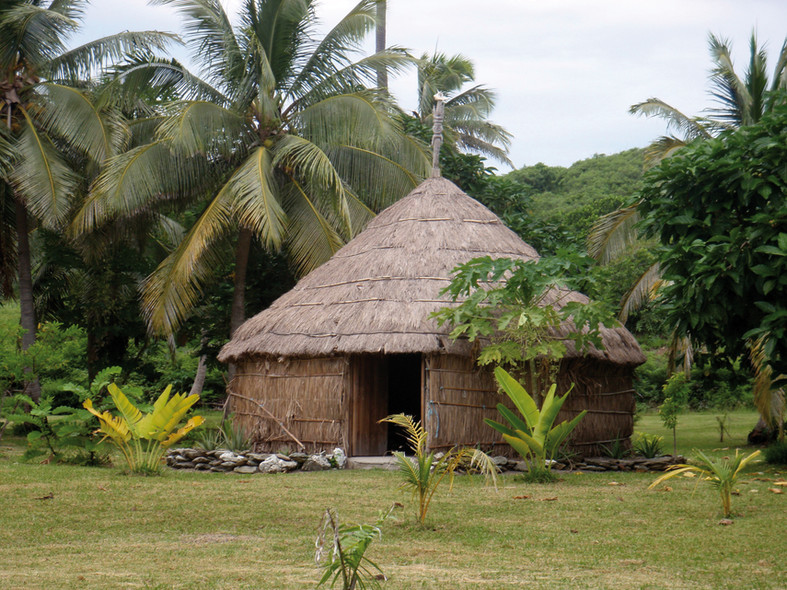
Case Kanak in the northern province, on the east coast of "The Rock"
From Maré To Lifou
The following night under a starry sky, we crossed from Maré to Lifou, helped along by a downwind breeze. I didn't sleep much, as there were some small, low, uninhabited islands along the route, and Jangada's radar hadn't worked for ages. I hadn't managed to get it repaired in New Zealand as I would have needed to take the boat to Auckland… I had thought that I might get it fixed in Nouméa, but there was no chance of that either… I'm rather skeptical of the accuracy of electronic charts, and so I spent a good part of the night peering into the dark, trying to work out our position as regards those unlit dark masses that we were passing alongside. At daybreak we sailed into the deep Wé Bay in Lifou, the biggest of the Loyalty Islands and which houses the smallest marina I've ever seen. Initially we obviously had no intention of going into the marina, as this was an idea (staying in marinas!) that had become totally alien to us since we had left France. But it so happened that it was difficult to anchor in Wé as there are coral outcrops all along the coastline, and the swell comes into the bay. So I decided to head up the little channel and gently squeeze into this micro-marina. Astonished locals watched as we performed a tight right turn.
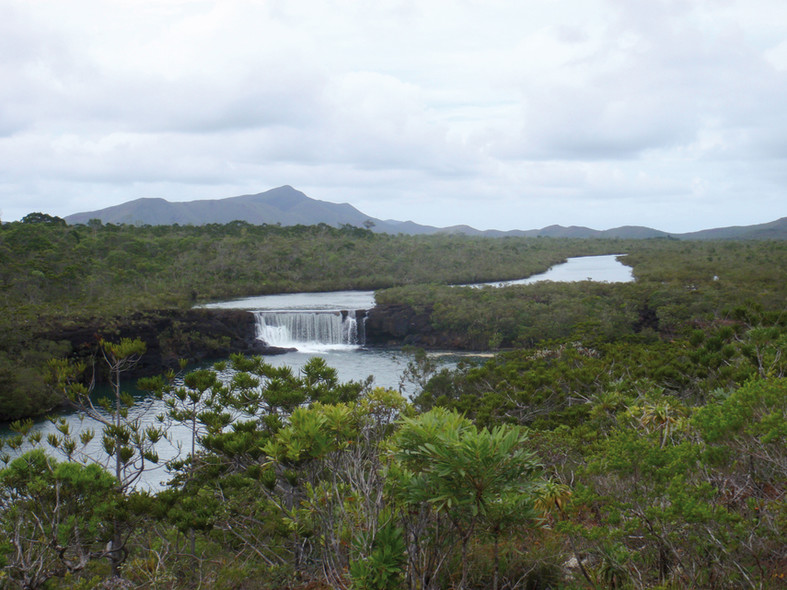
Southern Caledonian landscape…Magnificent!
In Wé, Jangada's size seemed out of place. We carried on regardless, heading into the tiny port, and then an unexpected miracle happened! For the last two years, the port facility managed by the local Melanesians had not had a Director. The previous one had died shortly after participating in the rescue operation of a yacht. However, just a few days previously, a new one had been appointed and was in the process of taking things over. Seeing us approaching, he started getting active on the dock by the harbormaster's office. Without asking him anything, he began to move another catamaran, in order to leave the best space free for us. Unbelieveable! I really appreciated this. It goes without saying that Jangada was one of the biggest sailing boats that had ever entered the Wé marina. I hesitantly asked how much this would cost, saying that we would only stay for a few hours, 24 hours maximum, depending upon how much time we would need to spend discovering the village of Wé, the capital of Lifou and the Loyalty Islands. He told me that as he had only just arrived in his post and had not had time to work on prices, Jangada's stay would be free! A nice surprise. I said to myself that one shouldn't always assume that locally-run provincial set ups are badly run. There must be some good ones! We made the most of this free berth in calm waters, under a baking sun and with free water and electricity the whole time! One of the first people that we met was William, director of Wé's only hotel, the Drehu Village. A mad sailing fan, he already knew about Jangada as he's an avid reader of Multihulls World. He astonished us by using all of our first names although he has never met us! I jokingly advised the kids to prepare for their future lives in the spotlight… Later while we took advantage of the hotel's internet access, William told us all about life on the Loyalty Islands, accompanied by a “cold one". We won't have particularly memorable souvenirs of our time in Wé, despite all the preparations that went on for the "Bingo" evening, which is so popular amongst the islanders. So, having ended our unexpected short stopover in Wé's marina, from where Jangada emerged cleaned with fresh water, and rinsed abundantly, like the laundry which had been put out to dry on the rigging. The weather was ideal for heading south towards Vanuatu, around 150 miles away. We sailed upwind, straight into a moderate tradewind. We were heading for Port Resolution, on the island of Tanna, at the foot of the Yasur volcano. It seemed strange to be going back on ourselves in terms of longitude and be heading east for Panama, as ever since we had left New Zealand we had been heading steadily homewards to France. Yet the Vanuatu archipelago seemed worth the detour, and later on we would head for the Louisiades in Papua New Guinea. So, it was time to hoist the fully-battened mainsail with the windlass and head east!
As we left, there were contrasting impressions in our wake…
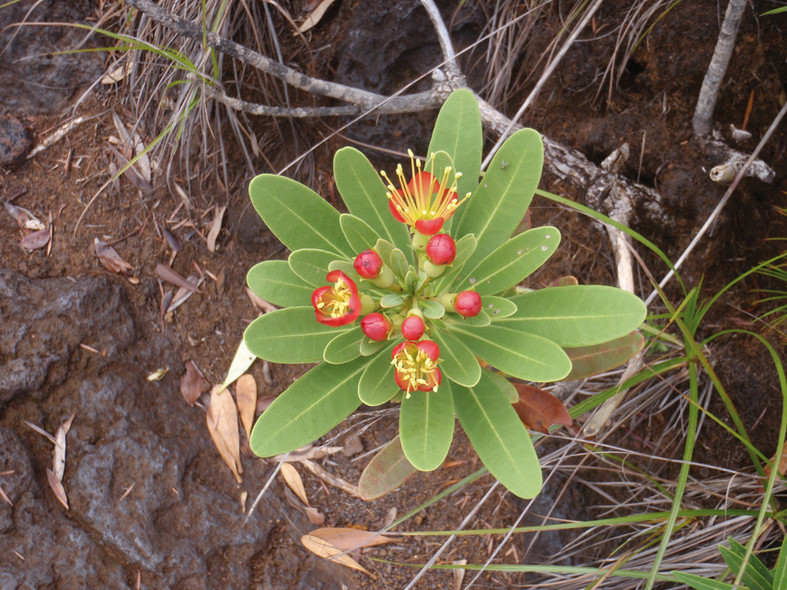
If you think that the fauna, especially underwater is amazing, so is the flora, like this local plant in the Prony region…
 Vote for your favorite multihulls!
Vote for your favorite multihulls! 

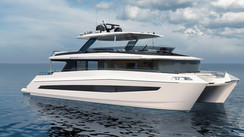
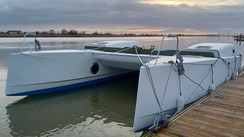
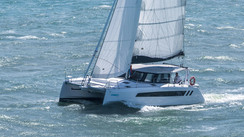
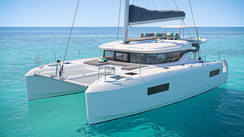
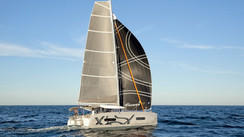
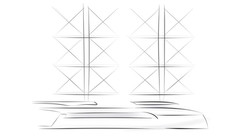
What readers think
Post a comment
No comments to show.